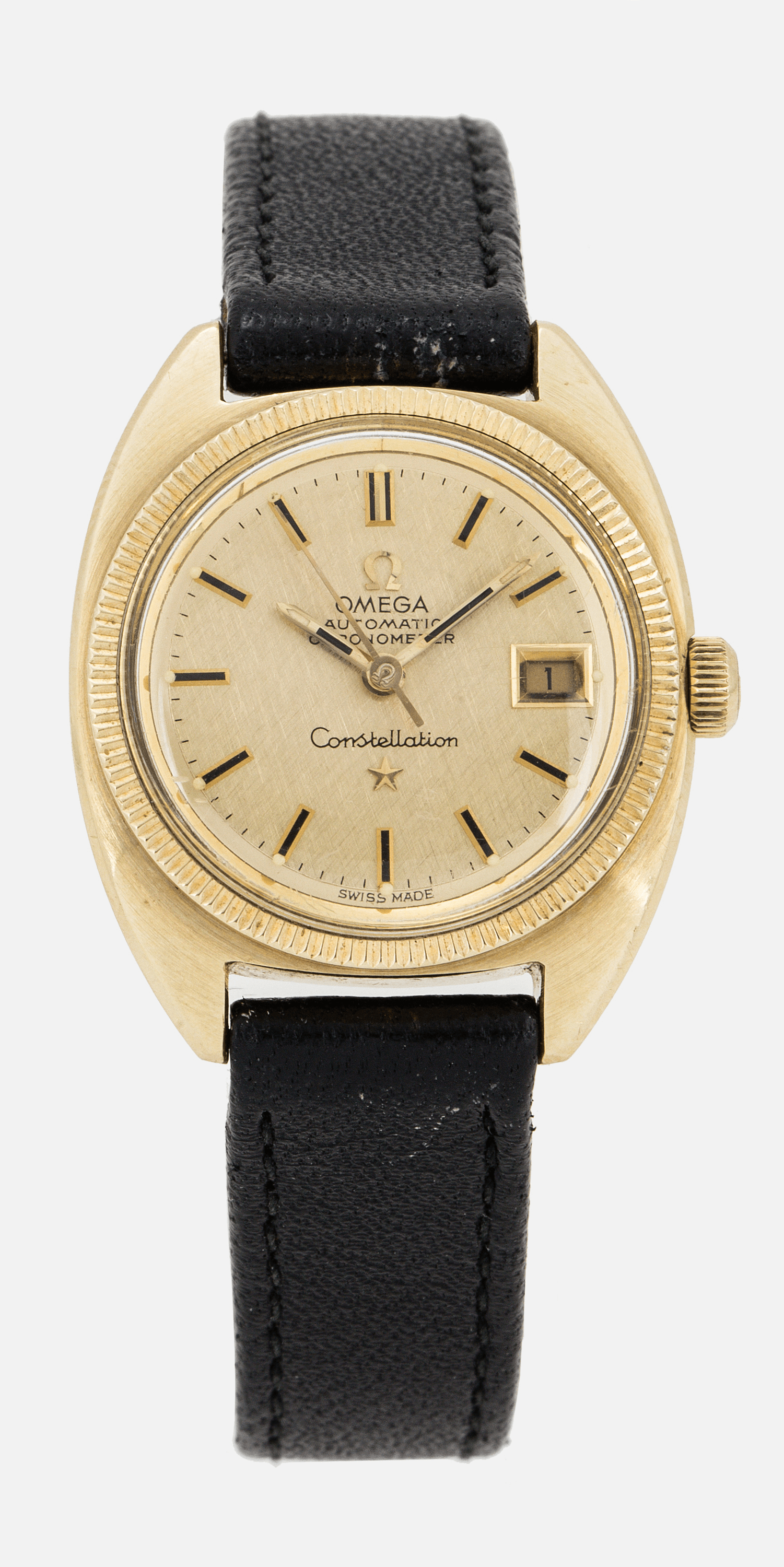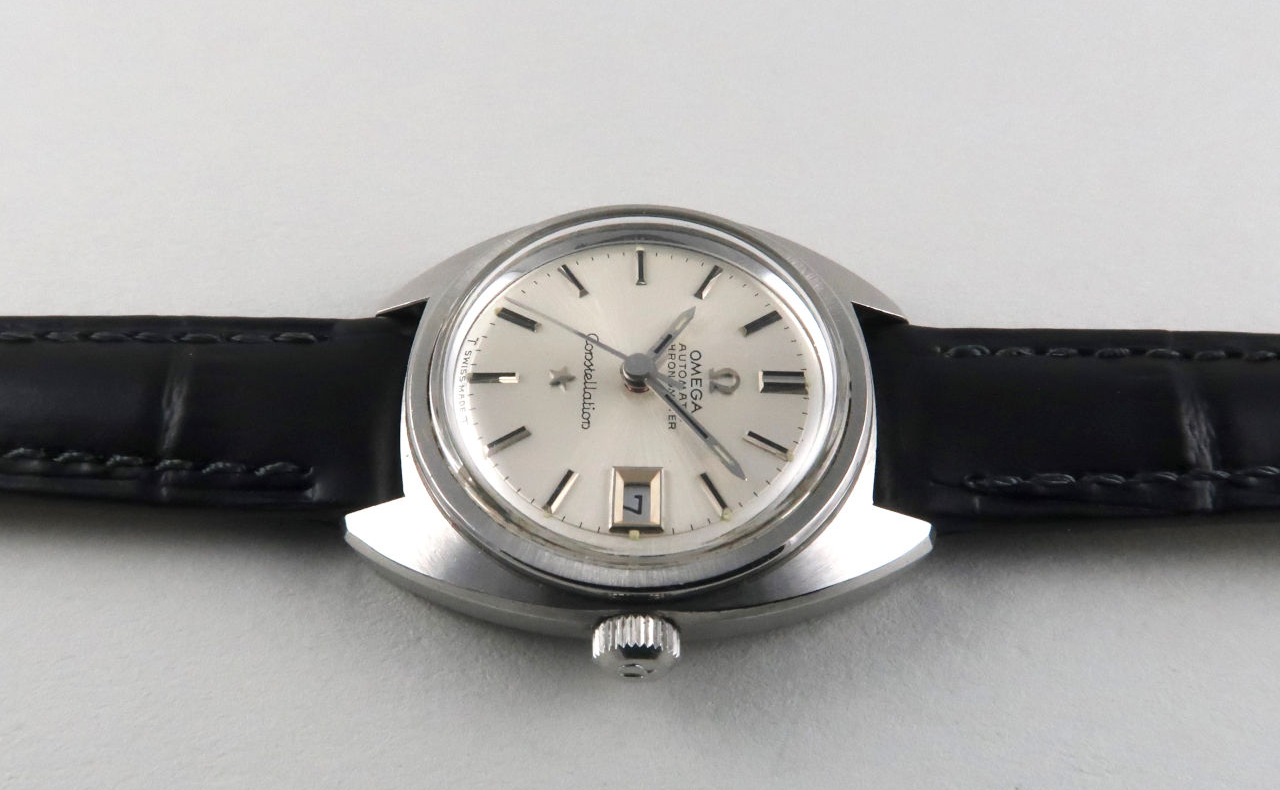Omega Constellation "C-Case"
| House | Omega |
| Category | Timepieces |
| Era | 1960s/1970s |
The Omega Constellation "C-Case" series, designed by Gerald Genta and introduced in the 1960s, epitomises elegance and precision.
This entry concentrates on the smaller 25mm variant of the Constellation "C-Case" timepieces which boasted the calibre 682 automatic movement, recognised for its accuracy and encased in a beautifully finished stainless steel body.
With the "C-Case" design, Omega deviated from traditional watch aesthetics, offering an innovative shape that became a hallmark of the era.
Collectors cherish these models for their quality, durability, and the stories they encapsulate about Omega's Golden Era. Today, they remain a coveted piece of Omega's legacy, representing a fusion of art, horological excellence, and historical significance.
In the orbit of vintage horology, the Omega Constellation stands as a celestial body of unrivaled repute, and its small "C-Case" variant—a product of the 1960s and 70s—embodies a design ethos that continues to resonate through time. As one delves into the annals of horological history, the Omega Constellation "C-Case" presents itself as a cornerstone of watchmaking excellence. This distinguished line, particularly its small scale variant crafted during the 1960s and 1970s, is a remarkable artifact that encapsulates the evolution of timepiece aesthetics and mechanical innovation of its epoch. This series, with its chronometric heart and sculptural aesthetics, exemplifies Omega's storied commitment to the marriage of form and function.
Casting a glance back to the mid-20th century, the Constellation "C-Case" emerged as a revelation. Designed by the legendary Gerald Genta—whose repertoire includes icons like the Audemars Piguet Royal Oak and the Patek Philippe Nautilus—the "C-Case" heralded a new age for Omega's venerable Constellation line. It was a distinct, bold departure from the more conservative Constellation models of the previous decade. With its contoured lines reminiscent of two interlocking Cs, a silhouette that became synonymous with the avant-garde ethos of the age. The "C-Case" was introduced in 1964. The reference 567.001 is a quintessential example, featuring a seamless blend of satin and polished finishes on a stainless steel tonneau-shaped case, embodying the era's architectural and design sensibilities.
Its construction—a stainless steel tonneau-shaped case featuring polished and satin finishes—was a tangible testament to Omega's craftsmanship. The attention to detail was meticulous: the case cradled the Omega calibre 682 automatic movement, a mechanical symphony of 24 jewels with a lever escapement and a mono-metallic balance pulsating at 19,800 beats per hour.
This was not merely a timepiece but a statement of luxury and precision. The dial, a pristine expanse of silvered or golden satin or textured linen, was marked by applied baton indexes filled with black inserts and luminescent dots. Baton hands with similar black inserts pointed to the passage of time, while a framed aperture appeared on some models at three o’clock to discreetly present the date.
The small "C-Case" Constellation defied the convention of merely being a scaled-down iteration of its larger counterpart. Instead, it stood as a a model with no-compromises in quality. With the observatory medallion on the caseback, and star gracing its dial, each watch in this line was a badge of honor, a wearable certificate of the brand's chronometric prowess.
Through the latter half of the 1960s, the "C-Case" design evolved, spawning variants that catered to diverse tastes while maintaining the core Constellation DNA. Among these, references 567.001 and 568.001 shone brightly, offering non-date and date functions respectively. Both were powered by precise calibres, the 672 and the 682, yet they shared an identical aesthetic signature.
Crafted with the watch connoisseur in mind, these Constellations transcended their timekeeping role. The dials bore the applied Omega logo, while the hands and markers were treated with an artistry that was as much a part of Omega's signature as the movements that powered them. For those who sought out precious metal variants, Omega offered these timepieces in 18K solid gold and even models embellished with diamonds on the dial.
The design of the "C-Case" was an act of balance—a harmony of brushed and polished surfaces that reflected Genta's mastery. The case was a canvas of contrasts: the angular high-polish bezel set against the brushed curvaceous case, the mirror finish of the chamfered edges juxtapose the matte case sides.
The Constellation's legacy, rooted in Omega's centennial celebration in 1952, had already been cemented by the time the "C-Case" made its debut. But the introduction of this distinctive design marked a significant pivot towards a future where watches would not only be judged by their mechanical excellence but also by the elegance of their design.
The "C-Case" models were an embodiment of this philosophy. They didn't just tell time; they told stories of the era's aspirations and Omega's horological ambitions. The small variants, in particular, captured this spirit with a grace that was both understated and assertive.




